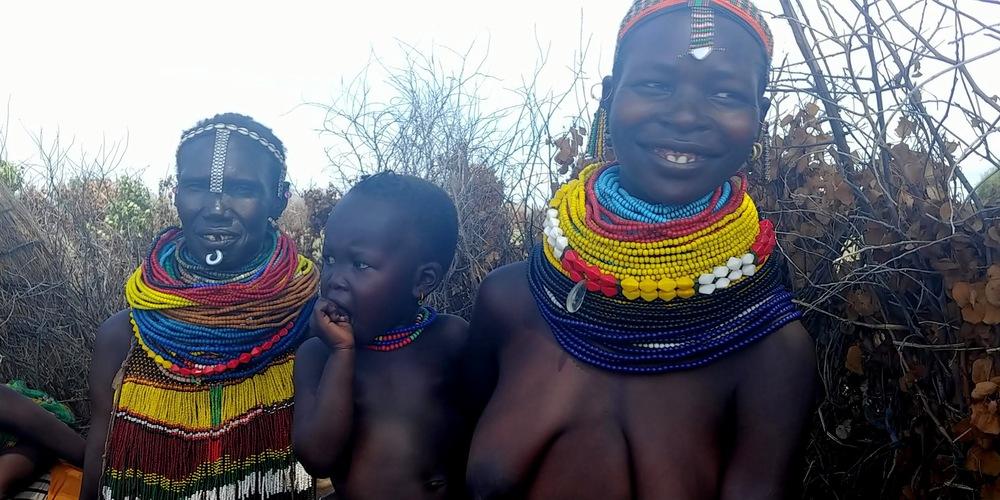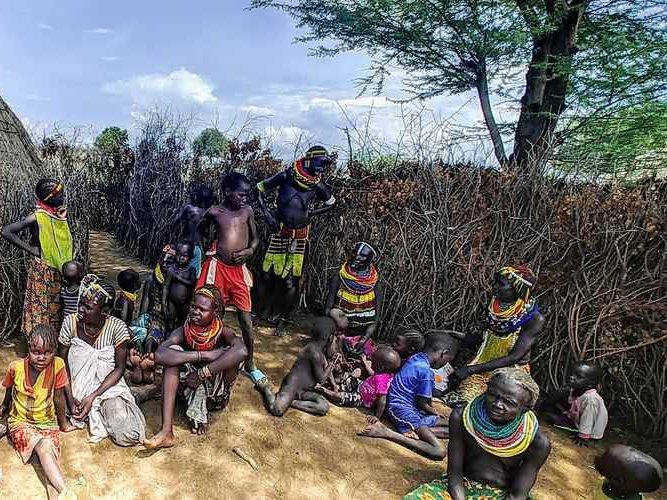The Nyangatom tribe, also known as Bume, is an agro-pastoralist community that resides on a vast expanse of land along the banks of the Omo River of Ethiopia. The Nyangatom tribe shares a border with the Ilemi Triangle, a disputed territory claimed by Ethiopia, Kenya, and South Sudan. The region where they reside is officially designated as the Nyangatom District, with Kangaten serving as its district capital. The area falls under the administration of the South Omo region of the Omo Valley and is characterized by semi-arid conditions, low altitudes, and warm temperatures.
The total population of the Nyangatom tribe is 20,500, with 10,300 men and 10,200 women. All members of the community reside in villages, with none living in urban areas. Traditional beliefs are practiced by 58.95% of the population, while 32.96% identify as Protestant Christians, and 1.22% practice Ethiopian Orthodox Christianity.

Culture and Way of Life of Nyangatom Tribe
The main source of income and livelihood for the tribe is livestock farming, supplemented by fishing in the Omo River. In times of drought, particularly during the small and main seasons from March to May, they engage in subsidiary activities such as gathering wild food and hunting in the riverine forest along the Omo River.
Internally, the community recognizes distinctions based on livelihood, settlement, clan, and age. There are seven main clans and 20 sub-clans identified within the community. The clan line always comes from the paternal side. According to Nyangatom customs, women are expected to stay at home and perform traditional roles such as caring for their children, preparing food, and caring for livestock.
Currently, there are two distinct settlement groups within the Nyangatom tribe: pastoralists and farmers. The first group crosses Ethiopia, the Ilmi Triangle and Topasa Land in South Sudan in search of green pastures for their livestock. The latter are mainly dedicated to agriculture as they lost their livestock, which was their only source of income, due to a pandemic coinciding with a period of drought. These tribes now rely on small-scale, rain- and recession-fed agriculture along the Omo and Kibish rivers. They grow crops such as sorghum, corn, beans and tobacco. Furthermore, the area is not suitable for livestock farming due to the presence of the tsetse fly, which causes painful bites and transmits deadly diseases.
Appearance
In terms of appearance, the Nyangatom tribe takes great pride in adorning their body with various decorations and accessories. Both men and women use these ornaments as a way to display their power, wealth, and status within the community. Body scarifications are a common practice among tribesmen, with intricate patterns and designs etched into their skin. These scarifications serve as a form of expression when a man kills an enemy. For women, it is just body decoration.

In addition to scarifications, the Nyangatom people also wear colorful beaded necklaces, spiral iron anklets, and bracelets. These accessories are often meticulously crafted to create unique, visually striking pieces. The bright colors and intricate designs of these ornaments not only enhance the wearer’s appearance but also serve as a symbol of his identity and cultural heritage.
Rite of Passage and Generation Set
There are four generational groups responsible for the administration and leadership of the tribe. Nyangatom men have a more active and visible role within the community. They engage in activities such as hunting, herding livestock, and participating in defense and warfare.
One of the most significant events in the Nyangatom tribe is the transition from childhood to adulthood. When a boy reaches the appropriate age, usually in his late teens or early twenties. His family organizes a rite of passage ceremony in front of the entire village. The young man has the task of spearing a bull. It symbolizes his willingness to take on responsibilities as an adult and become a respected member of the community. This initiation ceremony has great significance for the young man. He allows him to join the ranks of the ibex and grants him authority and respect within the tribe.
He becomes the village’s dedicated fighter and participates in the defense of their community and livestock. Furthermore, it opens up many dedicated fighters from the village and participates in the defense of their community and livestock. Furthermore, it opens up better marriage opportunities, as men who have undergone this rite of passage are considered more suitable and desirable partners.
Generations set within tribes are an important aspect of their social structure. Each generation is defined by a specific age range, and elders are respected for their wisdom and experience. They often take on leadership roles within the tribe, guiding younger members and making important decisions. The generational cycle typically lasts about 50 years. When Elders reach a certain age, they pass on leadership to subsequent generations. This is a symbolic transfer of power and responsibility, as the Sons take on the role of leaders and continue the traditions of their ancestors.
